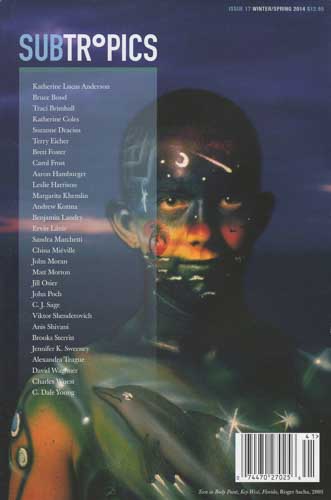Subtropics – Winter/Spring 2014
I was surprised when I realized that Subtropics was barely more than five years old. Of course the issue number is right there, announcing itself on the front cover, but I don’t think it’s entirely my fault for forgetting: published out of the University of Florida,Subtropics has the look, feel, and quality of a journal that’s been around for much longer. And if my word isn’t enough, you can check the records: last year alone, the journal had fiction chosen to appear in The O. Henry Prize Stories 2014 and Best American Short Stories 2014. I was surprised when I realized that Subtropics was barely more than five years old. Of course the issue number is right there, announcing itself on the front cover, but I don’t think it’s entirely my fault for forgetting: published out of the University of Florida,Subtropics has the look, feel, and quality of a journal that’s been around for much longer. And if my word isn’t enough, you can check the records: last year alone, the journal had fiction chosen to appear in The O. Henry Prize Stories 2014 and Best American Short Stories 2014.
And it was indeed the fiction that I was first drawn to in this issue. Subtropicsgets off to a great start with John Moran’s “Millennium,” a story with a first line that tells you all you need to know about the voice and movement of the piece: “When an apparition of the Virgin Mary appeared on the roof of our portable, carrying a hacksaw, a boom box, and a 12-pack of Bud, I was making hot-glue drip castles all across my Woman Astronaut Poster.” It’s a story ripe with religion, though not in the way that adds up to one clear discernible symbol or message—unless, of course, you want to put your critical skills to use analyzing how The Virgin Mary dances to “Tootsie Roll.” Moran’s story is hilarious, even though there are times, like when The Virgin Mary tells the kids, “No one but God wants to fuck me,” that it seems just plain wrong—or perhaps it’s the surprising direction of the heavenly apparition’s visit that creates the humor. Regardless, “Millennium” is a fun and smart story about innocence and indecency.
Another of my fiction favorites couldn’t be any more different from Moran’s piece. Subtropics has at least a fairly noticeable focus on translation, both in poetry and in prose, and Ervin Lázár’s “Schimpf, the Smoke,” translated from Hungarian by Andrea Nemeth-Newhauser, is, for me, the best of the lot. In this short, haunting piece, the “piano untuner” comes to a man’s house and untunes his piano. Though this seems like an innocuous act, it spurs Schimpf to dismantle the rest of his life, a clever and baffling plotline that leaves the reader feeling as naked and ridiculous as Schimpf at the end.
In addition to publishing one essay, a smart bit of criticism by Anis Shivani titled “Authorship in Contemporary American Literature,” this issue of Subtropics also includes many fine poems. My favorite was Matt Morton’s “Today’s Forecast,” a poem that embraces a general sense of breakdown and chaos, and not just in the weather. The failings and memories of individuals pale in comparison to the chaos of the fast-changing world, just as one individual’s troubles are so dwarfed by the imposing force of a natural disaster. Morton writes: “Somewhere, and engine sputters / and fails. Like so much else, it’s energy no longer / factors into the scheme of things.”
Subtropics is well designed, with glossy pages and a vibrant color, and the writing is incredible. In my opinion, there’s no reason Subtropics shouldn’t be considered one of the country’s top literary magazines.
[www.english.ufl.edu/subtropics]





